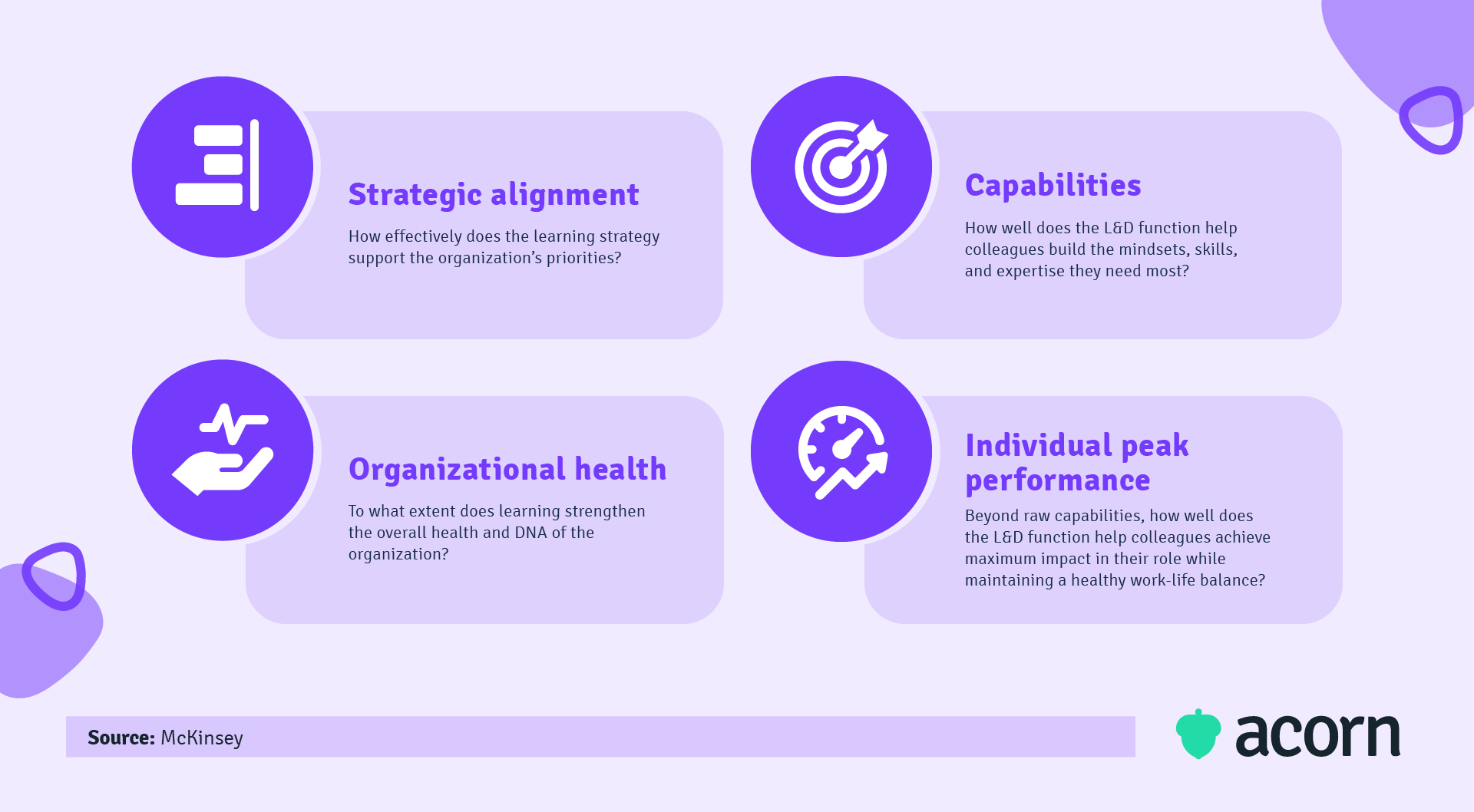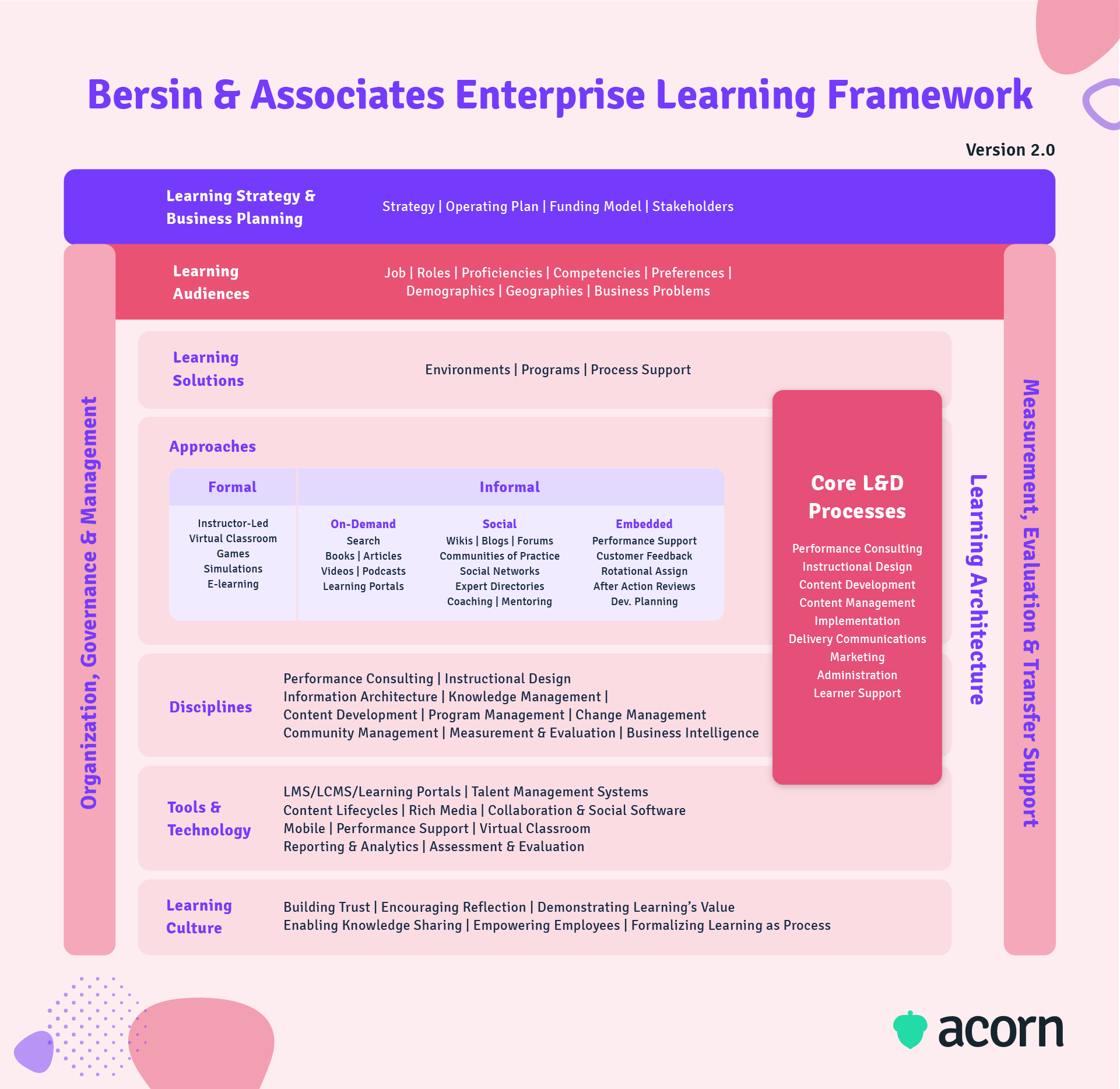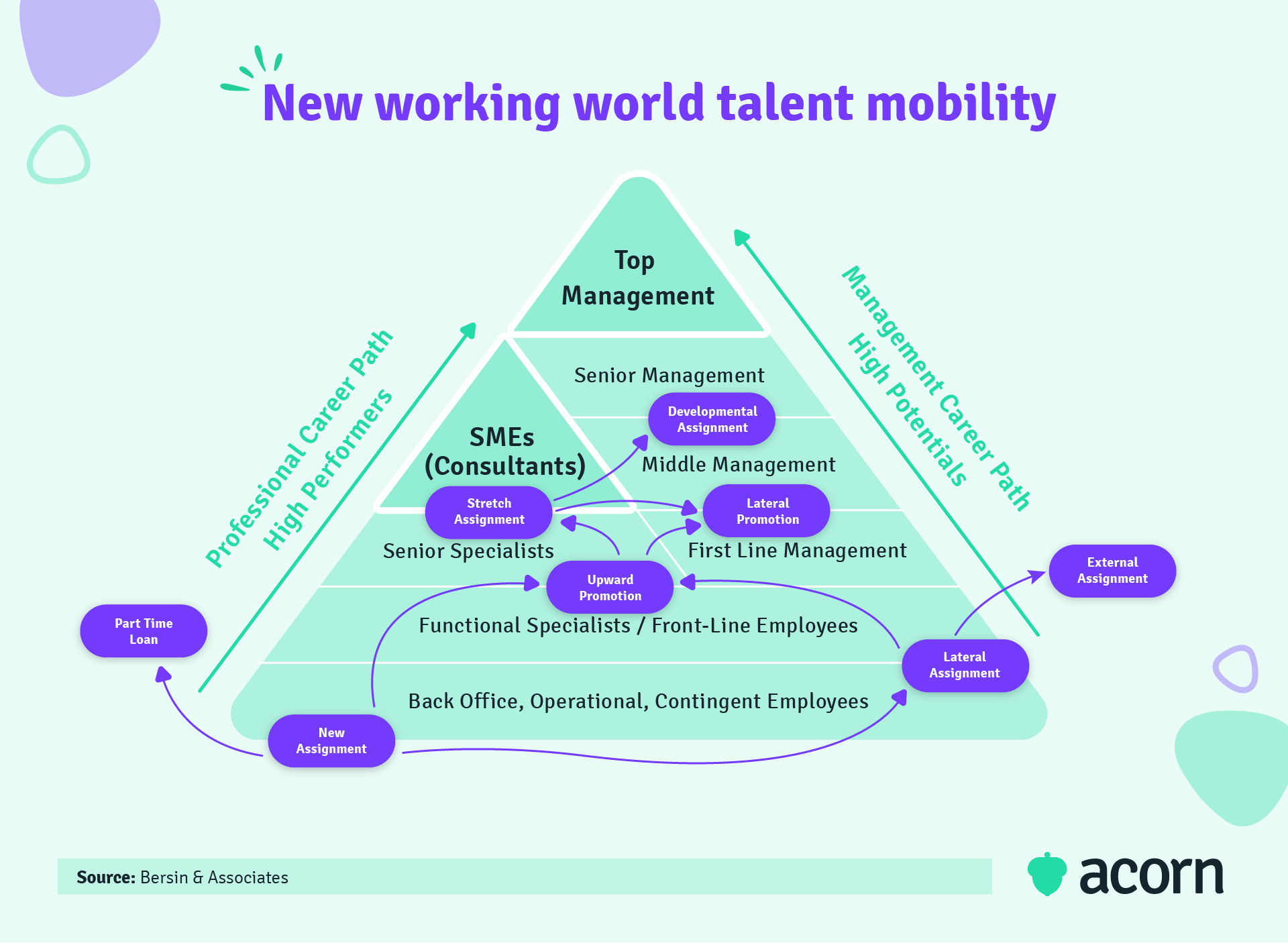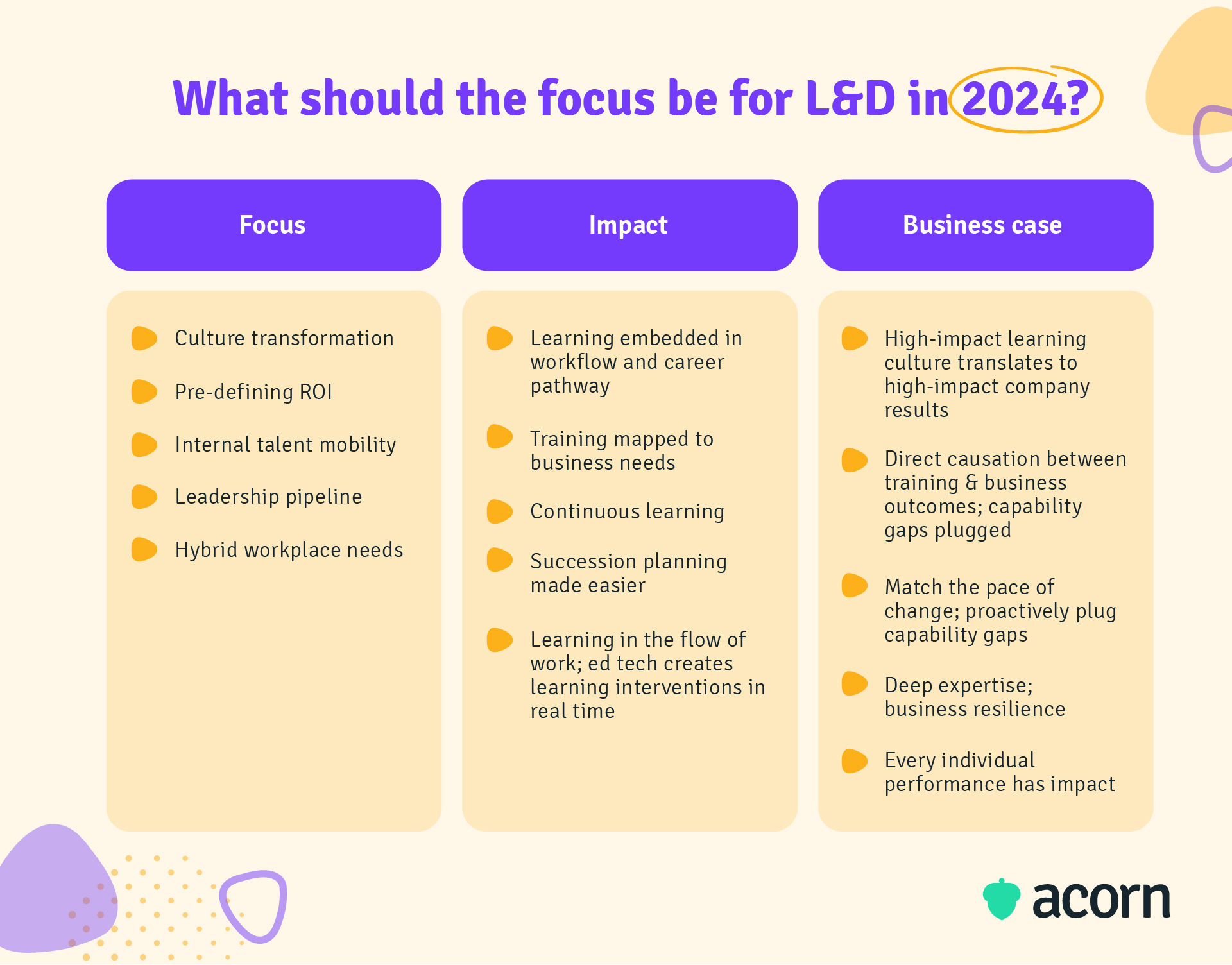How to Develop a Learning and Development Strategy for Impactful Employee Training
Reading Time:

Lead the pack with the latest in strategic L&D every month— straight to your inbox.
SubscribeRapid technological changes, digitally enabled customers, distributed workforces, and ever-shortening life spans for skills make the learning and development function more important than ever.
That’s without mentioning changing organisational needs related to workforce planning, roadmaps or business performance.
Proactive learning and development strategy is the way forward for L&D teams. Creating a solid strategy that addresses these external and internal business needs head-on helps avoid workforce or capability gaps down the line.
Let’s have a look at the importance of a learning and development strategy for impactful training, why a framework is helpful and how to present the business case for it.
What is a learning and development strategy?
A learning and development (L&D) strategy outlines how an organisation uses employee training to develop workforce capabilities, competencies, knowledge and skills. It shares a symbiotic relationship with organisational outcomes, being influenced by and used to support capability frameworks, business strategy and workforce plans to ensure future organisational success.
The impact of learning and development strategy on business outcomes
The pandemic and its ripple effects mean that the working world in which we work changes at a faster rate than ever. For long-standing or long-term business strategies, that’s hard to navigate.
Only 40% of companies say their learning strategy is aligned with business goals. Being out of sync with business needs means learning can’t truly be effective—and even if it somehow is, you likely can’t retrace your steps to prove direct causation.
A lot of the problems lie in the tech used; namely, in the fact many learning management systems aren’t designed to empower truly strategic L&D.
This is why we created the performance learning management system (PLMS). It’s the only solution that provides truly contextual learning opportunities by guiding learners step by step to master the capabilities of their job role. That gives you tangible behavioural improvements to show direct impacts on organisational performance.
We’d hedge a bet that most L&D KPIs wouldn’t account for sheer luck or even tenuous correlation. This makes proactive learning more important than ever, and learning and development strategies even more so.
Just why are learning and development strategies important?
A truly effective learning and development strategy follows people strategy, which in turn takes its cues from business strategy. That means that at any point in time, a solid L&D strategy should be systematically addressing high-level business needs like capability gaps, while meeting individual learning and development needs.
Yes, systematically—because if you’re plugging capability gaps, then you should be working from an exhaustive capability framework that’s based on your strategic direction. (Have we hammered home enough how full circle L&D should be?)
We all know people capabilities are important. Forgotten or outdated knowledge depletes the economic impact your workforce can have. It’s not just about upskilling anymore; proactive, guided learning interventions are necessary for developing the capabilities essential to business success so you have them when you need them.
We emphasise guided learning here, because it’s important to:
- Help your people develop capabilities in the most effective way for your learning culture.
- Support the transfer of learning onto the job post-training. McKinsey found that high-performing organisations focus on outcome-based metrics for learning, like performance, team effectiveness and business-process improvement.
- Ensure learning is actually impactful. Self-directed learning has its place later on in the learning journey (e.g. employees choosing capabilities of interest to study alongside their assigned, job-related set, which helps maintain motivation), but there’s no guarantee employees will self-select business-critical or timely learning topics to begin with.
Then there’s the financial factor to consider. Tailored training more efficiently utilises L&D funding and ensures initiatives are executed on time. This maintains executive buy in, while also giving basis for L&D strategy and capability assessments to scale as a company grows.
And the last benefit of a learning and development strategy is how it can help weather the economic storm. Capabilities are resolute, changing only if the business suddenly calls for it. The framework in which you train for them—a Capability Academy, as it’s known—is the dynamic part.
L&D isn’t necessarily meant to keep pace with what’s happening externally but rather business goals and internal events (mergers, product development, and the like). A flexible learning framework that draws upon the experience of internal experts and mentors, says Josh Bersin, ensures content is always relevant and reflective of dynamic business needs. This way, workplace learning is timely since it matches the cadence of short- and long-term business objectives as they evolve, rather than chasing competitors’ success.
How to develop a learning and development strategy
We’ve established that the core of L&D strategy should be meeting performance needs to fulfil business outcomes. McKinsey suggests four lenses for articulating and evaluating the impact of corporate learning.

Picking a lane, so to speak, gives you more clarity for the desired outcomes of your learning and development strategy. We recommend taking the Kirkpatrick approach to understand how to effectively create a learning and development strategy for your specific business needs.
It starts by defining what you want to achieve from training efforts, but specifically you’ll need to:
- Conduct a needs analysis
- Build an L&D action plan
- Design an L&D framework.
1. What are our business needs?
This is an important step as L&D can’t be all things to all people. It should look at the bigger picture: Proactively identifying the learning and development opportunities that will enable an organisation to deliver on strategic objectives.
Engage business leaders to discuss the desired internal environment and market position for the company. Compare this with the actual circumstances you are in and how organisational outcomes are currently addressed.
Some areas to look at when diagnosing learning and development needs include:
- Capability heatmaps or skills registers—these show the business-critical gaps already in L&D language.
- Team or department KPIs. The sales team not meeting their quarterly quota may exemplify a bigger problem in their abilities, for example.
- Customer or client satisfaction scores.
What all of these have in common is that a lack of knowledge, skills or attitudes can be established. Ergo, training can be developed to address these gaps.
2. What does a learning and development plan look like?
At this stage, you want to prioritise the gaps (capability or otherwise), and therefore the training, that will have the biggest business impact.
At an organisational level, PwC suggest starting with jobs that will be most affected by new technologies. Analytic workforce planning tools can help determine potential impacts on job roles and therefore the new capabilities needed to reroute those people into other roles.
HR and/or line managers can assess individual capability gaps. One activity to focus on here is change management. Enlisting mentors to help assuage any fears about individual transformation is a tactic for managing change. Empowering self-assessments of capabilities helps motivate employees while ensuring that any development plans remain business relevant. Both give L&D the information with which to a) build out personalised development plans and b) develop or source content that can plug capability gaps. This in turn means that any expenditures like learning technologies and systems of productivity can be more accurately planned for.
3. What framework will we work in?
Think of it as learning architecture: Creating a framework for a learning and development strategy gives a comprehensive foundation for the scope, purpose and activations. It also shapes the desired future state of your L&D function.
It’s important to define as it outlines:
- What activities need to be done and when
- Who is responsible for what
- The parameters that ensure everything will be done on time & within budget.

There are plenty of traditional approaches (blended learning, performance-based solutions and self-directed learning) you can apply to a framework at large. Josh Bersin’s learning in the flow of work is by and large the most popular learning and development strategy, not least because it reflects the way in which people are proven to learn.
The 70/20/10 approach
Achieving true behaviour change requires aftercare. The 70/20/10 approach is well-covered in L&D literature, which should give a good indication of its timelessness. The formula is as follows:
- 70% of learning occurs in real life, on-the-job experiences.
- 20% of learning comes from feedback and observation.
- Just 10% comes from formal training, which usually forms a base of knowledge and skills.
We’re not saying you need to follow this to the tee. Formal training programs will overtake informal at times, such as for compliance. Managers probably come closer to a 50/30/20 split. But we mention it because as much as a learning and development strategy should consider the learning element, you need to think about how professional development is contextualised and applied.
Creating a culture and employing systems that enable knowledge sharing and deep expertise puts you on par with true high-impact companies. What’s key here is that both formal and informal learning are embedded in culture. All learning then happens in the flow of work and lifelong learning begins.
Sidebar: This is why high-impact learning cultures are near impossible to compete with economically. High-performing organisations are 3x more likely to have a strong learning culture, with informal, on-the-job learning driving the greatest business value.
But why does this approach work so well for learning and development frameworks? People need real world context for capability development. It helps plug the disconnect between traditional development and today’s career paths, according to Deloitte. LinkedIn Learning found that informal, social learning activities increase learning 30x over.

So, while you’ll always have your high potentials and high performers, career development is incredibly different these days. Some activations to target training include:
- Stretch assignments
- Personal development plans
- Business leaders rotated through the L&D function
- Self-nomination for development, e.g. leadership skills.
And to support the learning culture itself:
- Culture used in recruitment
- Internal promotion
- Mentoring for succession
- Automated pathways & content mapping.
How to present a learning and development strategy
Inevitably, the key part of developing an L&D strategy will be getting buy in. It’s a pressure cooker situation for L&D leaders. C-Suite (aka those with their fingers on the coin purse) will want to know that there’s a return on investment (ROI) for any strategy implemented.
We recommend focusing on two pillars:
- Talking about L&D impacts in business language
- Establish L&D stakeholders and advocates.
Translate L&D ROI into business language
Don’t look at L&D ROI solely through the lens of, well, L&D. While knowledge retention and time to proficiency are solid metrics for improving learning efforts, they aren’t often considered impactful outside the L&D function. Business leaders are looking for strategically impactful metrics like engagement, profitability and retention.
Ergo, start talking about your learning and development strategy in the financial and operational language of the business. This means you can better show the commercial business case for it.
The cohesive element of your learning and development strategy is the focus for it. Like we said, L&D can’t be all things to all people. Pick a lane or two and show the strategic change of those focuses. It’ll make change easier to manage on L&D’s end and more palatable for everyone else.

This helps L&D as a whole be better understood at all levels of your organisation. And if L&D teams are better versed in business lingo and needs, then it’s also easier to challenge opinions or asks that could be detrimental to organisational training down the line.
Along the lines of bringing L&D to the business strategy party, keep track of the external business environment as much as the internal. That’s considerations like:
- The future of the industry we work in and the business itself
- The competitive landscape now and in the future
- Your customers and why you win in the market for them.
Establish stakeholders in organisational L&D
Ineffectively marketing L&D and its value is the pitfall to avoid here, especially the perception that L&D is episodic and adjacent to work rather than part of it.
We need not just the L&D team, but business leaders and other key job roles to advocate for L&D at every touchpoint. The key is to hone in on how a specific learning and development strategy benefits their priorities.
Business leaders
We’ll say it again: Every business leader wants training that addresses business goals and capability gaps. They have the power to make L&D a function that all other units need to work with, given the strategic impact it can have.
Partner with them to continually align learning and business goals so they see not that only is training developed to address business needs, but that their input matters. This is particularly important if you’re not working from a defined capability framework yet.
Line managers
Managers are closest to the performance action; they’re best placed to see if training is translating on the job and what capability gaps need to be addressed day-to-day. Any feedback they offer is invaluable since it’s backed by evidence. Plus, they’re vital to fostering a culture that encourages skills application post-training.
Make it easy for them: The power of automation means that very little manual labour is needed on their end to develop learning pathways. A learning management system (LMS) that can map content to capability frameworks means managers need only provide performance updates on their teams to L&D to ensure training is impactful. Reporting is also automated for them this way; they can receive emails on individual progress to aid performance reviews, for example.
HR leaders
While L&D often report into HR, there is value in a specific collaboration for training. HR see the recruitment, succession and retention aspects of learning programs, making training a key tool for human resources. Learning culture is a big pull for hiring and retaining talent; 94% of employees would stay at a company longer if it invested in developing them.
Consider the nuances in each skillset, too. Both L&D and HR are involved in onboarding, but the context each brings to creating that experience is different and therefore strengthened by the other.
IT
Introducing learning technology, like that LMS? IT will need to be in your corner. They’ll set the golden standards for accessibility and integrations, as well as providing ongoing tech support. Their tick of approval goes a long way with business leaders, managers and employees.
Involve them in the conversation before you make any purchases or big changes. Line up hands-on training, if need be, and get them to shortlist features that they know are necessary to integrating with your current tech stack. Be sure to show the pain points an LMS would solve for them, too (such as vendor support).
Employees
Then there’s employees, aka your learners. Their motivation and engagement is crucial to both the success of training (through uptake) and understanding that success (i.e. the factors that drive causation). Remember that employees share sentiments; positive word-of-mouth is priceless. Focus on how L&D is personalised by learning needs and pace and can be tailored to their career aspirations.
Key takeaways
Technology is finally catching up to processes in L&D. Proving the strategic value L&D can bring to business is much more easily done now than ever before.
Which is great to say, since proactive training that addresses complex business needs is the way to executive buy-in. Designing a focused learning and development strategy gets L&D teams one step closer to buy in, as it outlines the purpose, scope and tools to be used. Remember: To be truly impactful, employee training needs to work both to a learning framework and from a capability framework.